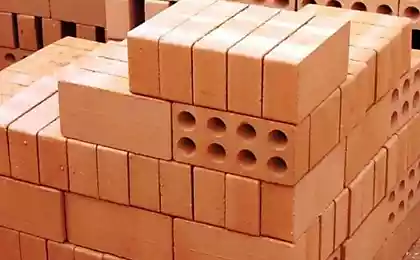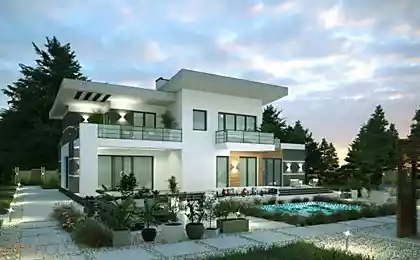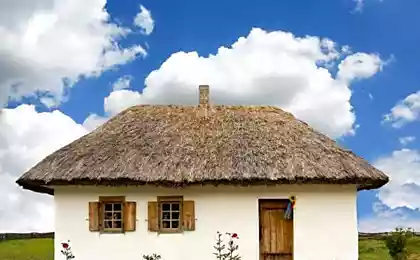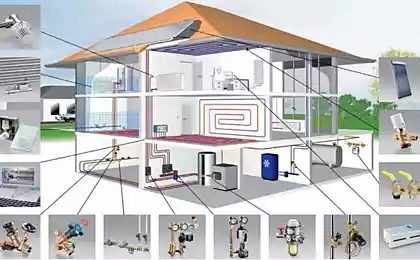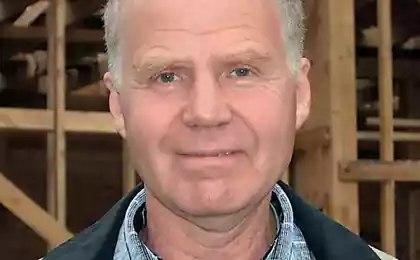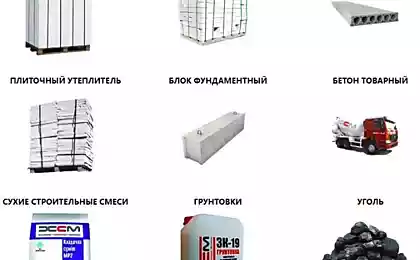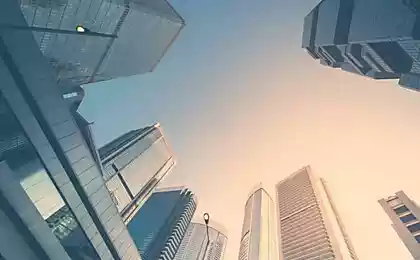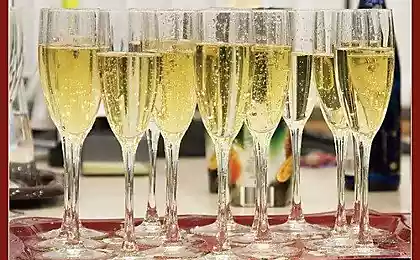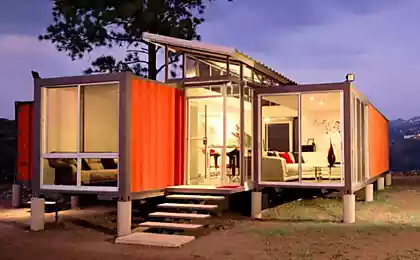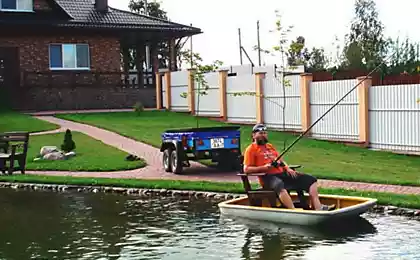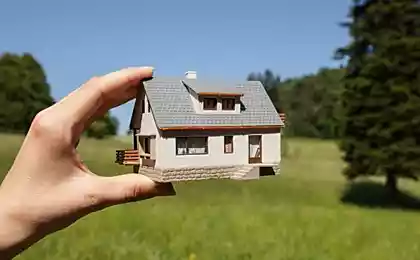568
Design features of houses of aerated concrete
Design is an important phase, which depend entirely on the operating characteristics of the building, as well as its durability and the comfort of living in it. In the construction market presents a large number of wall materials. Knowing the characteristics of a construction material, the designer can calculate the form-factor of a country house, which fully meets the requirements of the developer and complies with all technical regulations.
In this article, we, with the help of a specialist manufacturer of concrete blocks, will help you to understand the features of design and construction of houses of aerated concrete:
Construction practice shows that the Foundation of reliability depends largely on the lifespan of the house and its trouble-free operation. The Foundation distributes and transfers the weight from the structure to the base. So remember this rule:
Without ground surveys, construction of the house is blind, with all the ensuing negative consequences.To learn the structure of the soil and its bearing capacity, geological surveys are being done on the basis of which, pre-calculating the load of the building, selected and designed the Foundation for the cottage.
The Foundation must be sufficient for the projected building. Design of Foundation depends on the weight of the building. This load consists of self weight of all structures, operational (useful) loads, and snow loads, which depends on the construction area and take SP "Loads and impacts".
If you do not meet this requirement and build the Foundation of the model, without considering the peculiarities of the grounds in the area, we will get any redundant, and hence unnecessarily expensive design, with overruns of all construction materials or foundations with insufficient bearing capacity. That can lead to an emergency situation and subsequent costly repairs.
For concrete houses is most often used these types of Foundation as slab and strip Foundation.
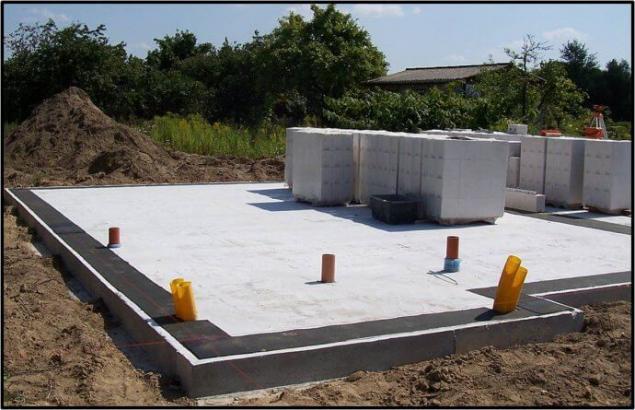
A monolithic concrete slab has minimal ground pressure and ensures the uniformity of the shrinkage and strip footing shallow easier to manufacture and less material-intensive.
In all cases, the optimal constructive solution for the choice of type of foundations can be taken only on the basis of geological surveys of the construction site.
Engineering Foundation under aerated concrete building, it should be remembered that this material has a low resistance to deformation bending. Monolithic rigid foundations with proper reinforcement, as well as laying nets, nagakanya jumper, the correct pairing of structures etc. to minimize deformation load associated with the possible shrinkage of the soil, which prevents cracks in concrete walls.
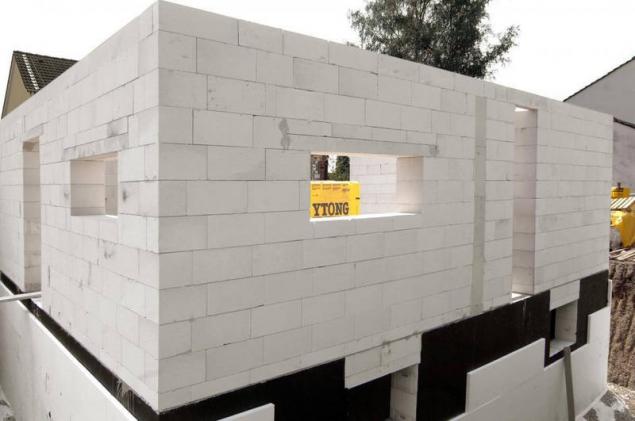
As mentioned above, the weight of the building influences the choice of Foundation type. The pattern of the following — the lighter walls (the material from which they are made), the less costly it turns out the Foundation. After all, under the light house does not need to make a powerful base. Will remember this moment. Go ahead.
Keep in mind that the properties of material used for walls, directly affect the features of design, construction and operation of the building. For example, consider the properties of gas and foam.
Aerated concrete and foam are types of cellular concrete — an artificial stone material on the basis of mineral binder with evenly distributed in terms of time. This gives the material high thermal insulation properties. The differences between the foam and concrete due to difference in technologies of their production, which, in turn, determine the quality of the final product.
The most common misconception of inexperienced developers to talk about foam - and aerated concrete as a single material.Foam, unlike autoclaved aerated concrete production, harden under natural conditions. This affects its final properties, namely, the unstable characteristics and geometry of products, which is often done in a controlled environment.
The aerated concrete can be manufactured only in a high-tech industrial production. This ensures its quality and specified characteristics that do not vary from batch to batch.
Principles of thermal calculation of aerated concrete at home
Now consider the design features of houses of aerated concrete from the viewpoint of thermal properties of this material. Indeed, in recent years, due to rising energy prices, there has been a surge of interest in the construction of economical, i.e. energy — saving houses.
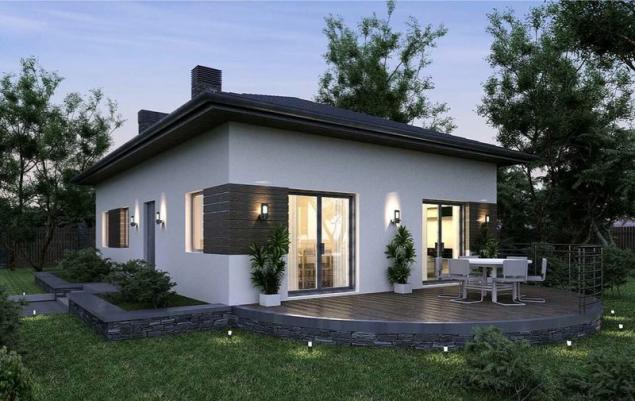
Such a house can save on heating, because of heat loss from the building is minimized. In accordance with the requirements of SNiP 23-02-2003 "Thermal protection of buildings", teploproduktia walls ® (for Moscow and MO) must conform 3.13 (m2*°C)/watt.
House with heat resistance walls to 4.5 (m2*°C)/W is considered to be energy efficient. If the thermal resistance is 6.5 (m2*°C)/W — passive.
Starting from these figures, we perform a simplified calculation to find out what should be the thickness of the concrete wall, corresponding to the standards.
For example, take the most popular brand of aerated concrete with density D400, strength class 2.5 with a coefficient of thermal conductivity 0.11 W/(m*°C) under normal operating conditions (A) and put the values in the following formula.
d = R * λ, where:
Ie wall thickness that meets the standards of thermal resistance, is 34 see Go ahead and take aerated concrete block the spindle size, namely width of 37.5 cm and modifies the formula.
R= d/λ,
And find the actual resistance to heat transfer of concrete walls with a width of 375 mm.
R= 0.375/0.11 = 3.4 (m2*°C)/W
Thus, we blocked an existing rule. In addition, the smaller the wall thickness, the greater the internal area of the house. Reducing the load on the Foundation and base and therefore is required to design a strong Foundation. There is no need for additional insulation of the walls. This makes it easier to construct the building and reduces the construction cost estimate.
When designing a building, it is necessary to proceed from requirements of sufficiency of the design and balance of all elements, which reduces the final cost.Correctly chosen wall material pulls the whole chain of the constructive advantages that we only need to use wisely. In addition, the aerated concrete can be easily processed, sawed, drilled and polished directly on the site of inexpensive hand tools. A direct analogue of the simplicity of the processing of aerated concrete – wood, and krupnoformatnoy and ease blocks significantly accelerates and simplifies the construction.
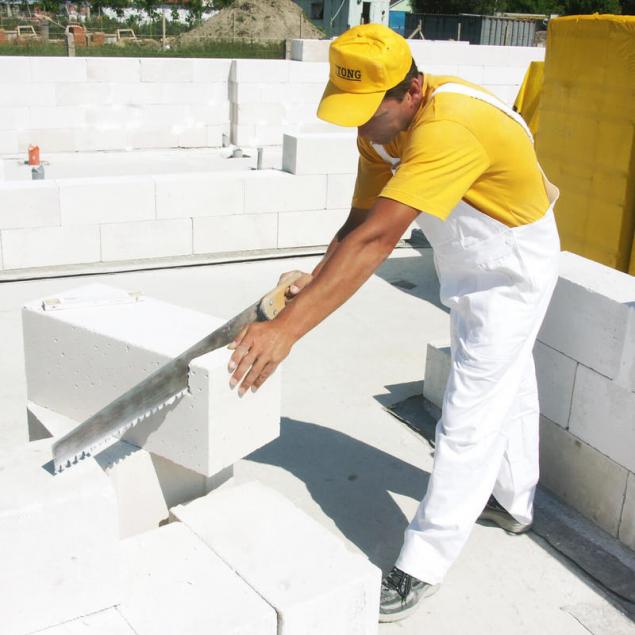
Thus, when designing the house, just think how convenient it is to work with material, whether to require the purchase of expensive tools. In addition to the additional costs, complexity of processing of the material leads to an increase of time for the erection of houses and construction cost estimates.
The most common errors
At the end of the article we present the most common mistakes that are allowed in the construction of houses of aerated concrete and which should be removed at the stage of design, using the technology recommended by the manufacturer.
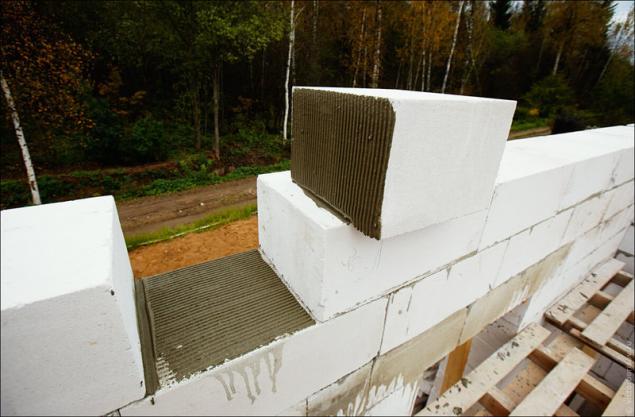
Source: www.forumhouse.ru/articles/house/7032
In this article, we, with the help of a specialist manufacturer of concrete blocks, will help you to understand the features of design and construction of houses of aerated concrete:
- The choice of Foundation house of aerated concrete and features of the material.
- Basic principles of thermal calculation.
- The most common mistakes made in the construction and design.
Construction practice shows that the Foundation of reliability depends largely on the lifespan of the house and its trouble-free operation. The Foundation distributes and transfers the weight from the structure to the base. So remember this rule:
Without ground surveys, construction of the house is blind, with all the ensuing negative consequences.To learn the structure of the soil and its bearing capacity, geological surveys are being done on the basis of which, pre-calculating the load of the building, selected and designed the Foundation for the cottage.
The Foundation must be sufficient for the projected building. Design of Foundation depends on the weight of the building. This load consists of self weight of all structures, operational (useful) loads, and snow loads, which depends on the construction area and take SP "Loads and impacts".
If you do not meet this requirement and build the Foundation of the model, without considering the peculiarities of the grounds in the area, we will get any redundant, and hence unnecessarily expensive design, with overruns of all construction materials or foundations with insufficient bearing capacity. That can lead to an emergency situation and subsequent costly repairs.
For concrete houses is most often used these types of Foundation as slab and strip Foundation.

A monolithic concrete slab has minimal ground pressure and ensures the uniformity of the shrinkage and strip footing shallow easier to manufacture and less material-intensive.
In all cases, the optimal constructive solution for the choice of type of foundations can be taken only on the basis of geological surveys of the construction site.
Engineering Foundation under aerated concrete building, it should be remembered that this material has a low resistance to deformation bending. Monolithic rigid foundations with proper reinforcement, as well as laying nets, nagakanya jumper, the correct pairing of structures etc. to minimize deformation load associated with the possible shrinkage of the soil, which prevents cracks in concrete walls.

As mentioned above, the weight of the building influences the choice of Foundation type. The pattern of the following — the lighter walls (the material from which they are made), the less costly it turns out the Foundation. After all, under the light house does not need to make a powerful base. Will remember this moment. Go ahead.
Keep in mind that the properties of material used for walls, directly affect the features of design, construction and operation of the building. For example, consider the properties of gas and foam.
Aerated concrete and foam are types of cellular concrete — an artificial stone material on the basis of mineral binder with evenly distributed in terms of time. This gives the material high thermal insulation properties. The differences between the foam and concrete due to difference in technologies of their production, which, in turn, determine the quality of the final product.
The most common misconception of inexperienced developers to talk about foam - and aerated concrete as a single material.Foam, unlike autoclaved aerated concrete production, harden under natural conditions. This affects its final properties, namely, the unstable characteristics and geometry of products, which is often done in a controlled environment.
The aerated concrete can be manufactured only in a high-tech industrial production. This ensures its quality and specified characteristics that do not vary from batch to batch.
Principles of thermal calculation of aerated concrete at home
Now consider the design features of houses of aerated concrete from the viewpoint of thermal properties of this material. Indeed, in recent years, due to rising energy prices, there has been a surge of interest in the construction of economical, i.e. energy — saving houses.

Such a house can save on heating, because of heat loss from the building is minimized. In accordance with the requirements of SNiP 23-02-2003 "Thermal protection of buildings", teploproduktia walls ® (for Moscow and MO) must conform 3.13 (m2*°C)/watt.
House with heat resistance walls to 4.5 (m2*°C)/W is considered to be energy efficient. If the thermal resistance is 6.5 (m2*°C)/W — passive.
Starting from these figures, we perform a simplified calculation to find out what should be the thickness of the concrete wall, corresponding to the standards.
For example, take the most popular brand of aerated concrete with density D400, strength class 2.5 with a coefficient of thermal conductivity 0.11 W/(m*°C) under normal operating conditions (A) and put the values in the following formula.
d = R * λ, where:
- d is the wall thickness.
- R — normalized resistance to heat transfer.
- λ — coefficient of thermal conductivity.
Ie wall thickness that meets the standards of thermal resistance, is 34 see Go ahead and take aerated concrete block the spindle size, namely width of 37.5 cm and modifies the formula.
R= d/λ,
And find the actual resistance to heat transfer of concrete walls with a width of 375 mm.
R= 0.375/0.11 = 3.4 (m2*°C)/W
Thus, we blocked an existing rule. In addition, the smaller the wall thickness, the greater the internal area of the house. Reducing the load on the Foundation and base and therefore is required to design a strong Foundation. There is no need for additional insulation of the walls. This makes it easier to construct the building and reduces the construction cost estimate.
When designing a building, it is necessary to proceed from requirements of sufficiency of the design and balance of all elements, which reduces the final cost.Correctly chosen wall material pulls the whole chain of the constructive advantages that we only need to use wisely. In addition, the aerated concrete can be easily processed, sawed, drilled and polished directly on the site of inexpensive hand tools. A direct analogue of the simplicity of the processing of aerated concrete – wood, and krupnoformatnoy and ease blocks significantly accelerates and simplifies the construction.

Thus, when designing the house, just think how convenient it is to work with material, whether to require the purchase of expensive tools. In addition to the additional costs, complexity of processing of the material leads to an increase of time for the erection of houses and construction cost estimates.
The most common errors
At the end of the article we present the most common mistakes that are allowed in the construction of houses of aerated concrete and which should be removed at the stage of design, using the technology recommended by the manufacturer.
- Laying the first row of blocks on the Foundation without waterproofing, which cuts off capillary rise of moisture. Also increased attention to the basement, where we can get water spray, repel the rain from the pavement. This place is worth defending advanced waterproofing materials, or process of penetrating water-repellent compositions.
- Brickwork aerated concrete cement is a special adhesive for thin-layered masonry. The result – thick masonry joints – "cold bridges". Instead of seams with a thickness of 1-2 mm, we get seams with a thickness of 1 cm. It also leads to a waste solution, and in terms of the volume of glue laying on of CPR more expensive.

- Avoiding the use of monolithic concrete laying nets when installing precast concrete floors and laying boards directly to the concrete. The result is due to point loads may arise chipped blocks. Nets evenly distributes the load on the wall.
- Device Nadolny concrete bridges and laying nets without thermal insulation liner with external parties (mineral wool or extruded polystyrene). As a result (if you do not plan the further insulation of external walls according to the technology of "wet facade") produces powerful "cold bridge", leading to significant heat loss.
- The rejection of the reinforcement of the masonry under the window openings. The masonry is recommended to strengthen the valve so that it is 0.5 m advocated the slope of the window opening.
- Use for external finishes are not vapor-permeable materials. Aerated passes the vapour so it finishes you should use a vapor permeable plaster or if montereycarmel type of facade, such as brick, provides a ventilated gap (width about 40 mm) steam to escape. At the bottom, to remove accidentally trapped in the gap of the moisture in the brick veneer project provides special drain holes for water output, which improves the humidity conditions of concrete blocks.
Source: www.forumhouse.ru/articles/house/7032

